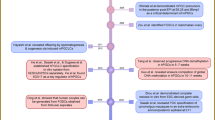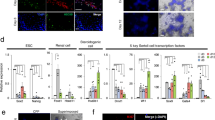Abstract
Germline stem cells (GSCs), often called spermatogonial stem cells, are unipotent stem cells that can give rise only to gametes. Under defined culture conditions, unipotent GSCs can be converted into pluripotent stem cells, termed as germline-derived pluripotent stem (gPS) cells. gPS cells can be differentiated into cells forming all three germ layers and germ cells. In this study, we describe a simple and robust protocol for the derivation of GSCs from adult mouse testis and the rapid and reproducible conversion of GSCs into gPS cells. Under our defined culture conditions, GSCs can be converted into gPS cells in ∼1 month. The initial number of plated GSCs and the culture time are two conditions that are critical for the successful conversion of GSCs into gPS cells. gPS cells are similar to embryonic stem cells, as judged by molecular and cellular properties and its development potential. Thus, generation of gPS cells holds potential for tissue regenerative medicine.
This is a preview of subscription content, access via your institution
Access options
Subscribe to this journal
Receive 12 print issues and online access
$259.00 per year
only $21.58 per issue
Buy this article
- Purchase on Springer Link
- Instant access to full article PDF
Prices may be subject to local taxes which are calculated during checkout





Similar content being viewed by others
References
Tegelenbosch, R.A. & de Rooij, D.G. A quantitative study of spermatogonial multiplication and stem cell renewal in the C3H/101 F1 hybrid mouse. Mutat. Res. 290, 193–200 (1993).
Kanatsu-Shinohara, M. et al. Long-term proliferation in culture and germline transmission of mouse male germline stem cells. Biol. Reprod. 69, 612–616 (2003).
Kubota, H., Avarbock, M.R. & Brinster, R.L. Growth factors essential for self-renewal and expansion of mouse spermatogonial stem cells. Proc. Natl. Acad. Sci. USA 101, 16489–16494 (2004).
Ko, K. et al. Induction of pluripotency in adult unipotent germline stem cells. Cell Stem Cell 5, 87–96 (2009).
Ogawa, T. et al. Derivation and morphological characterization of mouse spermatogonial stem cell lines. Arch. Histol. Cytol. 67, 297–306 (2004).
Kanatsu-Shinohara, M. et al. Generation of pluripotent stem cells from neonatal mouse testis. Cell 119, 1001–1012 (2004).
Seandel, M. et al. Generation of functional multipotent adult stem cells from GPR125+ germline progenitors. Nature 449, 346–350 (2007).
Izadyar, F. et al. Generation of multipotent cell lines from a distinct population of male germ line stem cells. Reproduction 135, 771–784 (2008).
Kanatsu-Shinohara, M. et al. Pluripotency of a single spermatogonial stem cell in mice. Biol. Reprod. 78, 681–687 (2008).
Guan, K. et al. Pluripotency of spermatogonial stem cells from adult mouse testis. Nature 440, 1199–1203 (2006).
Acknowledgements
We thank Martin Zenke, from RWTH Aachen, for conducting microarray experiments and Jeanine Müller-Keuker for preparing the illustrations. This work has been supported in part by the Deutsche Forschungsgemeinschaft DFG grant SCHO 340/4-1 and by the German Federal Ministry of Education and Research BMBF grant S01GN 0811.
Author information
Authors and Affiliations
Contributions
K.K. designed the protocol, generated and characterized the GSC and gPS cells and wrote the paper. M.J.A.-B., J.K. and M.S. characterized the GSC and gPS cells. H.R.S. designed the protocol and wrote the paper.
Corresponding author
Ethics declarations
Competing interests
The authors declare no competing financial interests.
Rights and permissions
About this article
Cite this article
Ko, K., Araúzo-Bravo, M., Kim, J. et al. Conversion of adult mouse unipotent germline stem cells into pluripotent stem cells. Nat Protoc 5, 921–928 (2010). https://doi.org/10.1038/nprot.2010.44
Published:
Issue Date:
DOI: https://doi.org/10.1038/nprot.2010.44
This article is cited by
-
Transient acquisition of pluripotency during somatic cell transdifferentiation with iPSC reprogramming factors
Nature Biotechnology (2015)
-
Genetic reporter analysis reveals an expandable reservoir of OCT4+ cells in adult skin
Cell Regeneration (2014)
-
The effects of Nanos2 on Boule and Stra8 in male germline stem cells (mGSCs)
Molecular Biology Reports (2013)
-
Autologous Pluripotent Stem Cells Generated from Adult Mouse Testicular Biopsy
Stem Cell Reviews and Reports (2012)
Comments
By submitting a comment you agree to abide by our Terms and Community Guidelines. If you find something abusive or that does not comply with our terms or guidelines please flag it as inappropriate.



